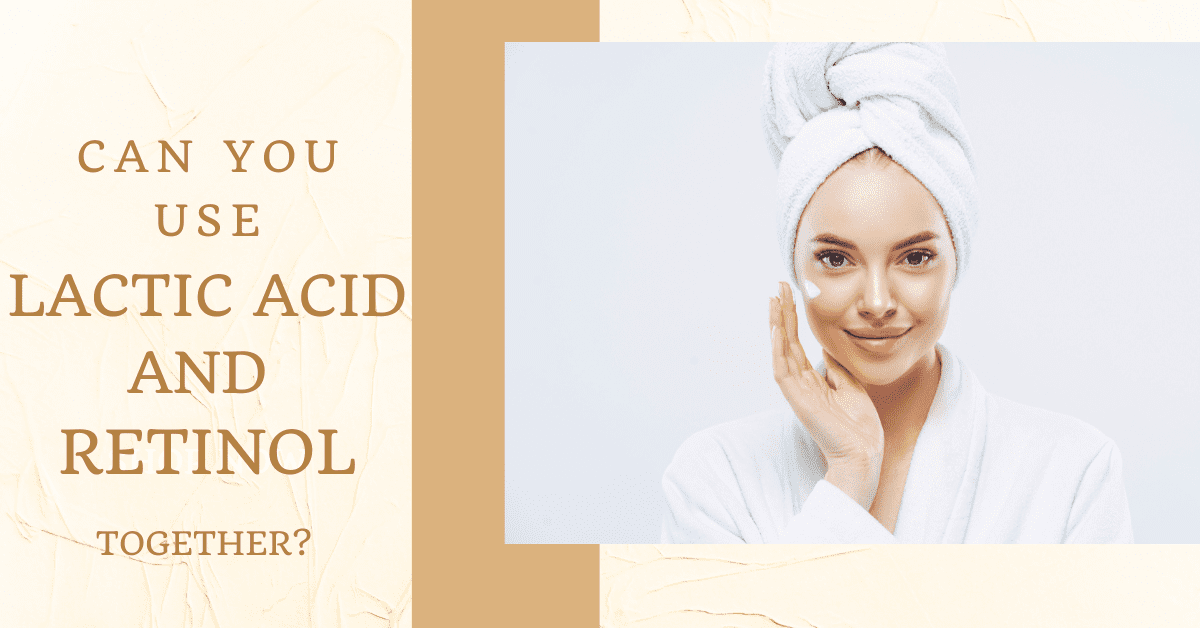Lactic acid and retinol may have been mentioned in the beauty industry, but what do these substances truly do? Retinol, a form of vitamin A, accelerates cell turnover while lactic acid, an alpha hydroxy acid (AHA), exfoliates the skin. Can you use lactic acid and retinol together in your skincare regimen even though they both have so many positive effects on the skin? To learn more, let’s compare lactic acid with retinol.
In This Article
What is Lactic Acid?
Lactic acid is an alpha hydroxy acid (AHA) that occurs naturally in milk and different fruits. Because of its exfoliating abilities, it is frequently used in skincare products. Lactic acid aids in the removal of dead skin cells when applied topically, producing a smoother and more luminous complexion.
How Frequently Can I Apply Lactic Acid to My Face?

Depending on your skin type and the product’s concentration, you should use lactic acid on your face sometimes. Generally speaking, it is advised to begin with once or twice a week and then progressively increase if your skin tolerates it. Some people could benefit from daily usage, but it’s important to keep an eye out for any irritation symptoms.
3 Benefits of Lactic Acid
1. Exfoliation
Lactic acid exfoliates the skin’s surface gently, clearing clogged pores and minimizing the look of wrinkles and fine lines.
2. Hydration
Lactic acid contains moisturizing characteristics, which, in contrast to certain other exfoliants, serve to keep your skin moisturized while enhancing its texture.
3. Brightening
By eliminating dull and dead skin cells, regular usage of lactic acid might result in a brighter complexion.
Describe Retinol
On the other hand, retinol, a vitamin A derivative, is frequently utilized in skincare due to its anti-aging properties. It aids in increasing collagen formation, minimizing wrinkles and fine lines, and enhancing skin texture.
Is Retinol Safe to Use Everyday?

Retinol usage frequency varies based on the concentration of the substance and the sensitivity of your skin. Usually, it’s advised to begin using it every other night and work your way up to using it every night if your skin can handle it. When taking retinol, it’s important to use sunscreen during the day since it might make your skin more susceptible to UV rays.
3 Advantages of Retinol
1. Anti-Aging
Retinol is well known for its anti-aging properties, which include the ability to lessen wrinkles, fine lines, and uneven skin tone.
2. Collagen Production
It promotes the synthesis of collagen, which keeps the skin firm and elastic.
3. Acne Treatment
Retinol can also effectively cure acne by clearing clogged pores and accelerating cell renewal.
Lactic Acid vs Retinol
- Lactic acid generally removes dead skin cells from the skin’s surface, whereas retinol promotes collagen formation and cell turnover to work deeper into the skin.
- Retinol can initially dry up and irritate delicate skin, but lactic acid is often gentler and healthier for it.
- While retinol is normally used at night, lactic acid can be applied either in the morning or the evening.
How To Use Retinol And Lactic Acid?

It’s crucial to include lactic acid and retinol into your skincare regimen gradually. But lactic acid before or after retinol, Here is a general rule:
- Once or twice a week, start by utilizing lactic acid in the evening.
- Apply retinol in the evenings if you don’t use lactic acid.
- If your skin can withstand it, you may gradually increase the frequency of lactic acid treatments, but you must always apply them on different evenings.
- Always use sunscreen, especially if you’re on retinol, as it might make you more sensitive to the sun.
When Should You Use Retinol and Lactic Acid?
As part of your nightly skincare regimen, you can apply lactic acid. You can switch between them on various evenings to prevent over-exfoliation as retinol is also frequently used at night.
What Are Some Advice for Combining Retinol with Lactic Acid?
- To gauge your skin’s tolerance, start by increasing the frequency slightly at first.
- To keep your skin moisturized, use a moisturizer after every application.
- When taking retinol, especially during the day, wear sunscreen with at least SPF 30.
- For specific guidance, speak with a dermatologist if you frequently feel dry or irritated.
FAQs on Lactic Acid and Retinol
Q1. Is lactic acid a retinol?
No, retinol and lactic acid are separate skincare components with unique properties and modes of action.
Q2. Lactic Acid or Retinol First?
Utilize them on different evenings if possible. To avoid overdosing on your skin, start with lactic acid and utilize retinol on alternate evenings.
Q3. Can I Use Lactic Acid with Retinol?
Since they might be too abrasive for the skin to use simultaneously, it is typically not advised. Alternate between them on several evenings.
Q4. Can I use Retinol at night and Lactic Acid in the morning?
You may use lactic acid in the morning and retinol at night, but while using retinol during the day, be sure to use sunscreen.
Wrapping Up
In conclusion, I hope you got your answer to ‘Can lactic acid be used with retinol?’ lactic acid and retinol are potent skincare components that, when utilized properly, provide a variety of advantages. Retinol treats anti-aging issues and acne, while lactic acid offers moderate exfoliation and hydration. It’s important to introduce these substances gradually and use sun protection when doing so.
You may take advantage of the benefits of lactic acid and retinol for a smoother, brighter, and more youthful complexion by adhering to a well-balanced skincare routine and paying attention to your skin’s demands. A dermatologist should always be consulted for specific advice depending on your skin type and objectives.
Hi, I'm Naznin! I really love making skin happy. I learned cool stuff about skincare and want to share it with you! Together, let's explore how to take care of our skin and feel awesome. Join me on this fun journey where we can be our beautiful selves!

